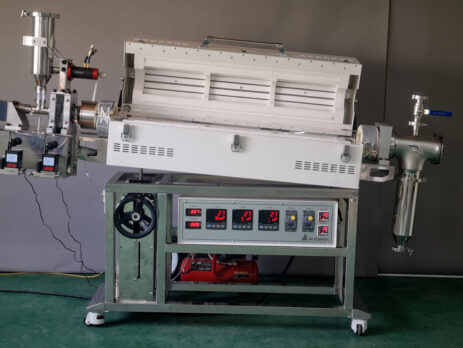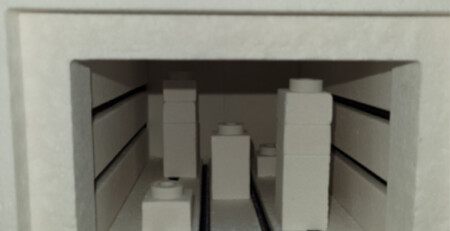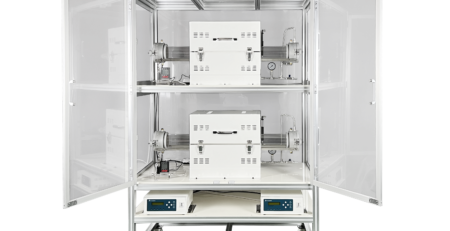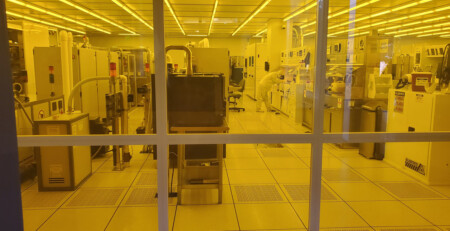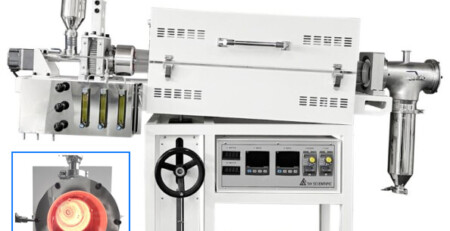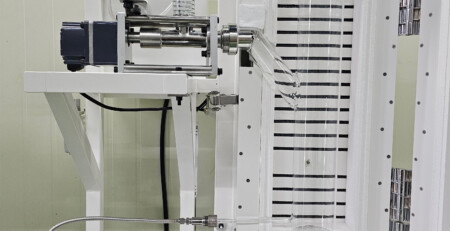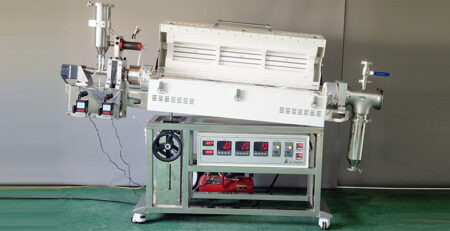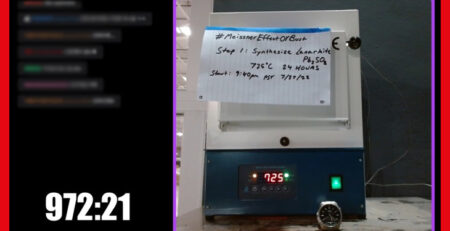Rotary Tube Furnace
Rotary tube furnaces are designed to continuously feed and mix samples during high-heat processing.
With large volume and gentle agitation, they’re used for organic matter, industrial materials, and even cutting-edge battery precursors and nanotechnology.
The SH Scientific line delivers exemplary performance and usability thanks to innovations like:
- Extra-large tube options up to 800 mm in diameter and 1500+ mm in length.
- Heating jackets for tar mitigation.
- A viewing window for easy observation while running.
- Feeder vibration and hammer systems to introduce samples uniformly and consistently.
- Vacuum integration for complete atmospheric control.
Below, we’ll walk through their design and some common uses, then highlight key features to look for when choosing a rotary tube furnace for your laboratory.
Rotary tube furnace design
Rotary tube furnaces ensure even heat exposure during continuous high-temperature processes such as calcination, pyrolysis, and chemical vapor deposition. Their key feature is a rotating and downward-tilting tube, which helps materials to pass through at a steady rate.
Functionally, they’re like higher-precision rotary kilns scaled down for lab use.
Like any tube furnace, rotary ones use a transparent cylindrical chamber made of materials like quartz, ceramic, or alumina.
The chamber is heated by anywhere from one to upwards of five heating zones, each corresponding to a Kanthal® heating element. Zones are managed by a programmable digital controller for stable, precise, and repeatable cycles.
Rotary tube chambers tend to be wider and longer than stationary ones—hence the larger number of heating zones—but they’re fundamentally similar in design.
With appropriate vacuum and gas flow equipment, they’re also an ideal environment for oxidation-prone samples.
However, rotary tube furnaces have two main differences:
- The tube rotates during operation, so the entire sample is equally exposed to the atmosphere and to the thermal conduction of the chamber. The goal is minimal sufficient agitation, so rotation is typically limited to 10–20 rpm.
- The tube tilts downward from the feeding end to the receiving vessel. Some models can tilt far more steeply than others, but angles beyond ~15° aren’t often necessary in practice.
Generally, samples are introduced via a feeder and collected in a container at the other end of the tube.
Feeder design has an outsized impact on day-to-day usability. Most feeders have at least one form of mechanical agitation to keep the material flowing, although designs vary widely between manufacturers. (Ours use three separate mechanisms, as we’ll cover later on.)
Applications of rotary tube furnaces
Many of the continuous thermal treatments that employ rotary furnaces—but certainly not all of them—are electrochemical in nature.
By way of comparison, full-size rotary kilns are more appropriate for lower-tech industrial processes, e.g., cement production. For reasons of size and safety, they’re typically installed outdoors or in enormous production plants.
Food waste, biochar & carbonization
Rotary tube furnaces make quick and consistent work of large volumes of organic materials.
Facilities rely on their uniformity and controlled feeding to pyrolyze food and vegetation into biochar, carbonize other organic matter into biofuels, and so forth.
Treatment protocols depend on feedstock quality and composition, so mechanical adjustment (e.g., feed rate) and multi-zone temperature control are essential for high-volume processing.
High-purity battery materials
From electric vehicles to commercial energy storage, we’re witnessing unprecedented demand for high-purity battery materials.
A rotary tube furnace maximizes the homogeneity of these kinds of samples, including lithium cobalt oxide (used in cathodes) and lithium hexafluorophosphate (an electrolyte salt). Its high high capacity and continuous feeding also help labs keep pace with ever-growing demand.
High-capacity silicone–carbon composites
High-capacity Si–C materials are a class of anode materials produced through chemical vapor deposition (CVD).
They require an inert atmosphere and precise thermal gradients, both of which a standard vacuum tube furnace can provide.
But Si–C materials also benefit from rotation, which deposits silicon more evenly, resulting in maximally consistent electrochemical performance throughout each sample.
Hydrogen fuel batteries
Heat treatment is essential for hydrogen fuel cell materials like nanoparticle catalysts, carbon nanotubes (CNTs), boron nitride nanotubes (BNNTs) and PEMs.
Standard tube furnaces sometimes suffice, but rotary tube furnaces have two key advantages.
First, and most obviously, their steady agitation helps produce more consistent results. In addition, their larger chambers give labs enough throughput to scale along with market demand.
Battery waste recycling
At the other end of a battery’s life, rotary tube furnaces can help recover valuable (and environmentally problematic) materials like lithium, cobalt, and nickel.
Some of these metals are rather volatile and sensitive to oxidation, so even heating and perfect inert gas saturation are invaluable.
If demand for battery recycling keeps pace with demand for battery inputs, then we expect high-capacity rotary furnaces and kilns to become even more critical in the near future.
Oxidation processes
High volumes of coatings, catalysts, and other industrial materials are produced through oxidation processes.
Rotary tube furnaces ensure consistent results and material performance thanks to precise thermal control and steady agitation.
Some processes and substrates are extremely sensitive to the composition of the atmosphere. This calls for additional gas flow management equipment, available as an add-on for virtually all SH Scientific models.
Reduction processes
Reduction processes turn commonplace oxides and ores into purer electrical and industrial inputs.
Beyond the requisite thermal and atmospheric management, rotary tube furnaces offer consistency for large, continuously-fed samples. Their rotation makes them essential for high-yield, high-purity metallurgical processes.
Choosing the right rotary tube furnace
Choosing the right model is fundamentally similar to picking a standard tube furnace.
Both have similar factors of tube size, heating configuration, and atmospheric control.
However, rotary tube furnaces come with the added considerations of tilting and rotation, feeding mechanisms, and different (but overlapping) size and temperature ranges.
Temperature considerations
Rotary tube furnaces are generally limited to about 1100°C (as in our line), or occasionally as high as 1500°C.
If you require more extreme temperatures, then a standard, stationary tube furnace is ideal. Our own models are capable of temperatures up to 1800°C.
Tube configuration
Rotary tube chambers tend toward the larger side. A typical starting point is 100–120mm in diameter, although we can supply tubes up to 800mm—on par with industrial rotary kilns.
Our standard chamber length is 1500mm, which strikes a good balance between capacity, heating uniformity, and space-efficiency.
Regardless of tube size, SH furnaces tilt between 0°–15°. This covers the vast majority of uses. Upon request, steeper angles may be possible with certain configurations.
Heating zones
Given their wider and longer chambers, rotary tube furnaces also have more heating zones than stationary models do.
Our standard configurations are two to five zones, each 300 mm in length. For stricter control over gradients, more zones are feasible as a custom request.
As a standard, our furnaces use Kanthal® A-1 elements and ceramic insulation to maximize longevity and energy efficiency.
Feeding system
Well-designed feeding mechanisms use some form of agitation to prevent materials from clumping and clogging before they even reach the chamber.
Our feeders optionally use three complementary features to suit the widest possible range of materials.
- A screw conveyor turns at 0.5–10 rpm to introduce the sample steadily and gradually.
- A vibration mechanism imparts gentle but high-frequency force to minimize clumping.
- A hammer lets technicians impart a quick knock (or succession of knocks) to dislodge larger or denser clumps inside the feeding vessel.
Vacuum & inert gas management
Many thermal treatments are sensitive to or dependent upon the chamber’s atmosphere.
The proven solution is a vacuum pump and chiller, managed by a digital mass flow controller and back pressure regulator. This is available as a turn-key configuration for all SH rotary tube furnaces.
Before shipment, our rotary tube furnaces undergo a series of tests, including rotation tests, heating tests, and vacuum retention tests. Notably, the vacuum retention test is performed while the tube is in motion and inert gas is introduced to create an oxygen-free environment after a vacuum is established.
Viewing features
Even with all the instrumentation in the world, a visual check is still the best way to make sure the sample is evenly distributed.
Unfortunately, many manufacturers make it impossible to check for build-up without opening the furnace.
The SH Scientific line takes a different approach: a quartz viewing port at the end of the tube lets users see the sample while the furnace operates. It’s safe, easy, and non-disruptive to observe and adjust the angle or rotating speed on the fly.
Tar mitigation
Certain organic materials result in tar condensation and build-up, posing a risk to performance and safety.
SH rotary tube furnaces use a heating jacket to minimize tar build-up in the first place. It’s a simple but extremely effective way to extend the furnace’s working life.
Getting started with SH Scientific
Our rotary tube furnaces offer world-class precision and safety at an unrivaled value.
Every model reflects decades of real-world feedback from research universities, state and federal government labs, and private-sector R&D teams.
And thanks to in-house engineering and end-to-end control over production, we specialize in customizations that the bigger brands will seldom accommodate.
To discuss specs and requirements, or to learn more about purchasing and installation, please reach out to our US sales team.

